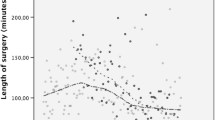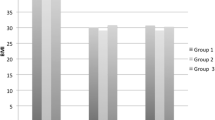Abstract
Background
As a result of increasing numbers of patients with morbid obesity there is a worldwide demand for bariatric surgeons. The Roux-en-Y gastric bypass, nowadays performed mostly laparoscopically (LRYGB), has been proven to be a highly effective surgical treatment for morbid obesity. This procedure is technically demanding and requires a long learning curve. Little is known about implementing these demanding techniques in the training of the surgical resident. The aim of this study was to evaluate the safety and feasibility of the introduction of LRYGB into the training of surgical residents.
Methods
All patients who underwent LRYGB between March 2006 and July 2010 were retrospectively analyzed. The procedure was performed by a surgical resident under strict supervision of a bariatric surgeon (group I) or by a bariatric surgeon (group II). The primary end point was the occurrence of complications. Secondary end points included operative time, days of hospitalization, rate of readmission, and reappearance in the emergency department (ED) within 30 days.
Results
A total of 409 patients were found eligible for inclusion in the study: 83 patients in group I and 326 in group II. There was a significant difference in operating time (129 min in group I vs. 116 min in group II; p < 0.001) and days of hospitalization. Postoperative complication rate, reappearance in the ED, and rate of readmission did not differ between the two groups.
Conclusions
Our data suggest that under stringent supervision and with sufficient laparoscopic practice, implementation of LRYGB as part of surgical training is safe and results in only a slightly longer operating time. Complication rates, days of hospitalization, and the rates of readmission and reappearance in the ED within 30 days were similar between the both groups. These results should be interpreted by remembering that all procedures in group I were performed in a training environment so occasional intervention by a bariatric surgeon, when necessary, was inevitable.




Similar content being viewed by others
References
Buchwald H, Avidor Y, Braunwald E, Jensen MD, Pories W, Fahrbach K, Schoelles K (2004) Bariatric surgery: a systematic review and meta-analysis. JAMA 292(14):1724–1737
Rovito PF, Kreitz K, Harrison TD, Miller MT, Shimer R (2005) Laparoscopic Roux-en-Y gastric bypass and the role of the surgical resident. Am J Surg 189(1):33–37
Higa KD, Ho T, Boone KB (2001) Laparoscopic Roux-en-Y gastric bypass: technique and 3-year follow-up. J Laparoendosc Adv Surg Tech A 11(6):377–382
Nguyen NT, Stevens CM, Wolfe BM (2003) Incidence and outcome of anastomotic stricture after laparoscopic gastric bypass. J Gastrointest Surg 7(8):997–1003
Buchwald H, Estok R, Fahrbach K, Banel D, Sledge I (2007) Trends in mortality in bariatric surgery: a systematic review and meta-analysis. Surgery 142(4):621–632 discussion 632-635
Podnos YD, Jimenez JC, Wilson SE, Stevens CM, Nguyen NT (2003) Complications after laparoscopic gastric bypass: a review of 3,464 cases. Arch Surg 138(9):957–961
Hutter MM, Randall S, Khuri SF, Henderson WG, Abbott WM, Warshaw AL (2006) Laparoscopic versus open gastric bypass for morbid obesity: a multicenter, prospective, risk-adjusted analysis from the National Surgical Quality Improvement Program. Ann Surg 243(5):657–662 discussion 662-666
Nguyen NT, Slone JA, Nguyen XM, Hartman JS, Hoyt DB (2009) A prospective randomized trial of laparoscopic gastric bypass versus laparoscopic adjustable gastric banding for the treatment of morbid obesity: outcomes, quality of life, and costs. Ann Surg 250(4):631–641
Puzziferri N, Austrheim-Smith IT, Wolfe BM, Wilson SE, Nguyen NT (2006) Three-year follow-up of a prospective randomized trial comparing laparoscopic versus open gastric bypass. Ann Surg 243(2):181–188
Higa KD, Boone KB, Ho T (2000) Complications of the laparoscopic Roux-en-Y gastric bypass: 1,040 patients-what have we learned? Obes Surg 10(6):509–513
Schauer PR, Ikramuddin S (2001) Laparoscopic surgery for morbid obesity. Surg Clin North Am 81(5):1145–1179
Tice JA, Karliner L, Walsh J, Petersen AJ, Feldman MD (2008) Gastric banding or bypass? A systematic review comparing the two most popular bariatric procedures. Am J Med 121(10):885–893
Leyba JL, Aulestia SN, Llopis SN (2011) Laparoscopic Roux-en-Y gastric bypass versus laparoscopic sleeve gastrectomy for the treatment of morbid obesity. A prospective study of 117 patients. Obes Surg 21(2):212–216
Ali MR, Tichansky DS, Kothari SN, McBride CL, Fernandez AZ Jr, Sugerman HJ, Kellum JM, Wolfe LG, Demaria EJ (2010) Validation that a 1-year fellowship in minimally invasive and bariatric surgery can eliminate the learning curve for laparoscopic gastric bypass. Surg Endosc 24(1):138–144
Higa KD, Boone KB, Ho T, Davies OG (2002) Laparoscopic Roux-en-Y gastric bypass for morbid obesity: technique and preliminary results of our first 400 patients. Arch Surg 135(9):1029–1033 discussion 1033–1034
DeMaria EJ, Sugerman HJ, Kellum JM, Meador JG, Wolfe LG (2002) Results of 281 consecutive total laparoscopic Roux-en-Y gastric bypasses to treat morbid obesity. Ann Surg 235(5):640–645 discussion 645–647
Kligman MD, Thomas C, Saxe J (2003) Effect of the learning curve on the early outcomes of laparoscopic Roux-en-Y gastric bypass. Am Surg 69(4):304–309 discussion 309–310
Oliak D, Ballantyne GH, Weber P, Wasielewski A, Davies RJ, Schmidt HJ (2003) Laparoscopic Roux-en-Y gastric bypass: defining the learning curve. Surg Endosc 17(3):405–408
Schauer P, Ikramuddin S, Hamad G, Gourash W (2003) The learning curve for laparoscopic Roux-en-Y gastric bypass is 100 cases. Surg Endosc 17(2):212–215
Dresel A, Kuhn JA, Westmoreland MV, Talaasen LJ, McCarty TM (2002) Establishing a laparoscopic gastric bypass program. Am J Surg 184(6):617–620 discussion 620
Pournaras DJ, Jafferbhoy S, Titcomb DR, Humadi S, Edmond JR, Mahon D, Welbourn R (2010) Three hundred laparoscopic Roux-en-Y gastric bypasses: managing the learning curve in higher risk patients. Obes Surg 20(3):290–294
Gonzalez R, Nelson LG, Murr MM (2007) Does establishing a bariatric surgery fellowship training program influence operative outcomes? Surg Endosc 21(1):109–114
Oliak D, Owens M, Schmidt HJ (2004) Impact of fellowship training on the learning curve for laparoscopic gastric bypass. Obes Surg 14(2):197–200
Dindo D, Demartines N, Clavien PA (2004) Classification of surgical complications: a new proposal with evaluation in a cohort of 6,336 patients and results of a survey. Ann Surg 240(2):205–213
Stefanidis D, Kuwada TS, Gersin KS (2011) The importance of the length of the limbs for gastric bypass patients-an evidence-based review. Obes Surg 21(1):119–124
Steele KE, Prokopowicz GP, Magnuson T, Lidor A, Schweitzer M (2008) Laparoscopic antecolic Roux-en-Y gastric bypass with closure of internal defects leads to fewer internal hernias than the retrocolic approach. Surg Endosc 22(9):2056–2061
Nguyen NT, Goldman C, Rosenquist CJ, Arango A, Cole CJ, Lee SJ, Wolfe BM (2001) Laparoscopic versus open gastric bypass: a randomized study of outcomes, quality of life, and costs. Ann Surg 234(3):279–289 discussion 289–291
Papasavas PK, Caushaj PF, McCormick JT, Quinlin RF, Hayetian FD, Maurer J, Kelly JJ, Gagne DJ (2003) Laparoscopic management of complications following laparoscopic Roux-en-Y gastric bypass for morbid obesity. Surg Endosc 17(4):610–614
Acknowledgments
We thank Maurik Stomps for his artistic impression of the three most important technical steps of the laparoscopic Roux-en-Y gastric bypass.
Disclosures
Drs. G. I. T. Iordens, R. A. Klaassen, E. M. M. van Lieshout, B. I. Cleffken, and E. van der Harst, have no conflicts of interest or financial ties to disclose.
Author information
Authors and Affiliations
Corresponding author
Rights and permissions
About this article
Cite this article
Iordens, G.I.T., Klaassen, R.A., van Lieshout, E.M.M. et al. How to Train Surgical Residents to Perform Laparoscopic Roux-en-Y Gastric Bypass Safely. World J Surg 36, 2003–2010 (2012). https://doi.org/10.1007/s00268-012-1620-2
Published:
Issue Date:
DOI: https://doi.org/10.1007/s00268-012-1620-2




